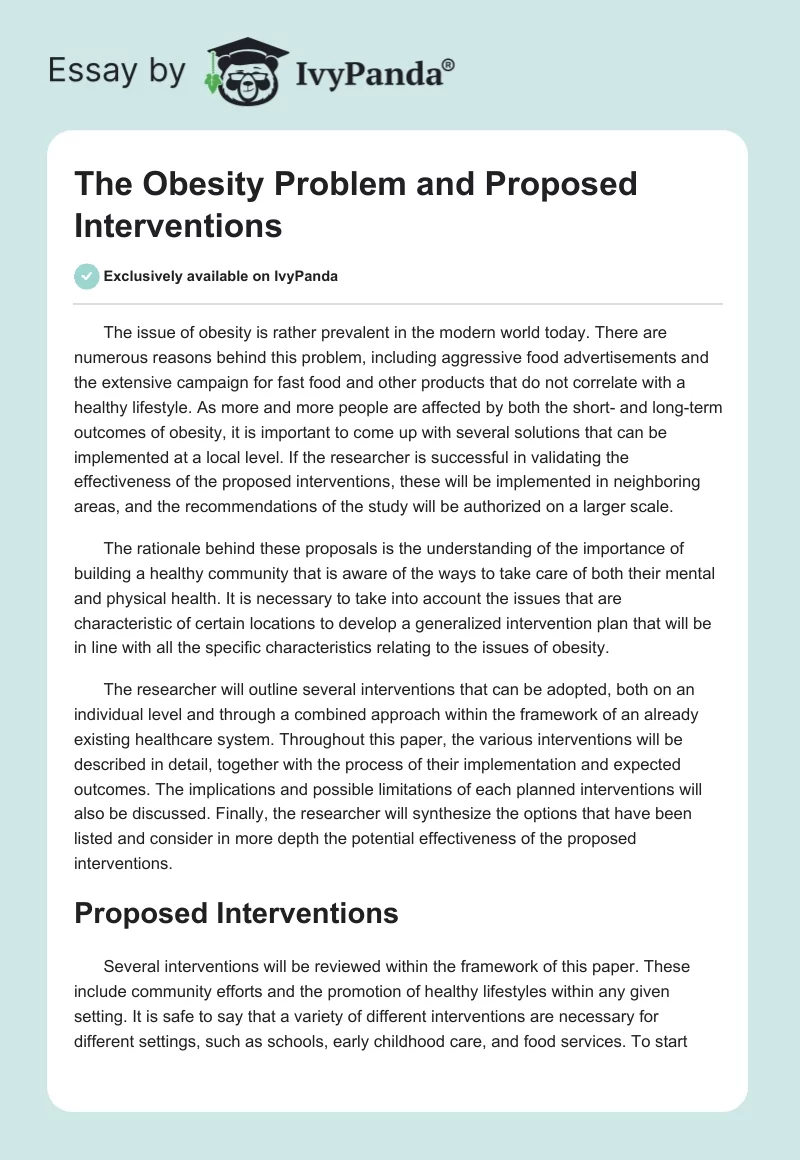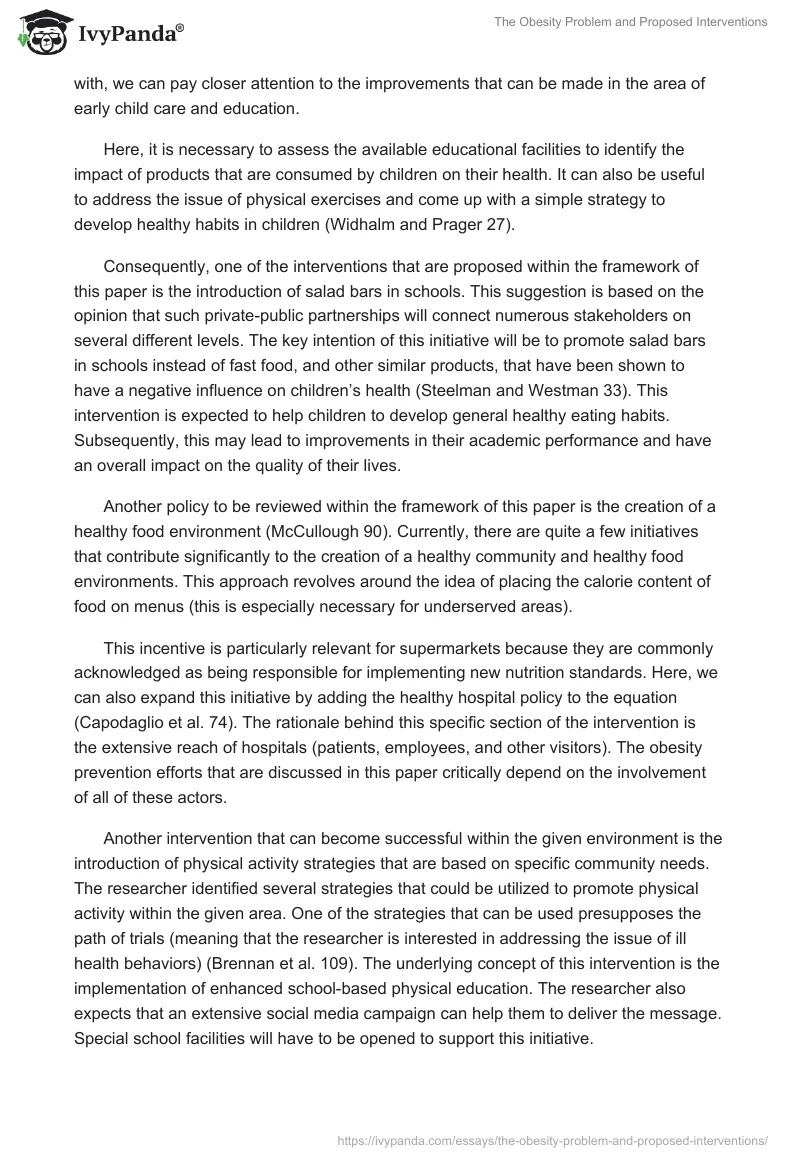The issue of obesity is rather prevalent in the modern world today. There are numerous reasons behind this problem, including aggressive food advertisements and the extensive campaign for fast food and other products that do not correlate with a healthy lifestyle. As more and more people are affected by both the short- and long-term outcomes of obesity, it is important to come up with several solutions that can be implemented at a local level. If the researcher is successful in validating the effectiveness of the proposed interventions, these will be implemented in neighboring areas, and the recommendations of the study will be authorized on a larger scale.
The rationale behind these proposals is the understanding of the importance of building a healthy community that is aware of the ways to take care of both their mental and physical health. It is necessary to take into account the issues that are characteristic of certain locations to develop a generalized intervention plan that will be in line with all the specific characteristics relating to the issues of obesity.
The researcher will outline several interventions that can be adopted, both on an individual level and through a combined approach within the framework of an already existing healthcare system. Throughout this paper, the various interventions will be described in detail, together with the process of their implementation and expected outcomes. The implications and possible limitations of each planned interventions will also be discussed. Finally, the researcher will synthesize the options that have been listed and consider in more depth the potential effectiveness of the proposed interventions.
Proposed Interventions
Several interventions will be reviewed within the framework of this paper. These include community efforts and the promotion of healthy lifestyles within any given setting. It is safe to say that a variety of different interventions are necessary for different settings, such as schools, early childhood care, and food services. To start with, we can pay closer attention to the improvements that can be made in the area of early child care and education.
Here, it is necessary to assess the available educational facilities to identify the impact of products that are consumed by children on their health. It can also be useful to address the issue of physical exercises and come up with a simple strategy to develop healthy habits in children (Widhalm and Prager 27).
Consequently, one of the interventions that are proposed within the framework of this paper is the introduction of salad bars in schools. This suggestion is based on the opinion that such private-public partnerships will connect numerous stakeholders on several different levels. The key intention of this initiative will be to promote salad bars in schools instead of fast food, and other similar products, that have been shown to have a negative influence on children’s health (Steelman and Westman 33). This intervention is expected to help children to develop general healthy eating habits. Subsequently, this may lead to improvements in their academic performance and have an overall impact on the quality of their lives.
Another policy to be reviewed within the framework of this paper is the creation of a healthy food environment (McCullough 90). Currently, there are quite a few initiatives that contribute significantly to the creation of a healthy community and healthy food environments. This approach revolves around the idea of placing the calorie content of food on menus (this is especially necessary for underserved areas).
This incentive is particularly relevant for supermarkets because they are commonly acknowledged as being responsible for implementing new nutrition standards. Here, we can also expand this initiative by adding the healthy hospital policy to the equation (Capodaglio et al. 74). The rationale behind this specific section of the intervention is the extensive reach of hospitals (patients, employees, and other visitors). The obesity prevention efforts that are discussed in this paper critically depend on the involvement of all of these actors.
Another intervention that can become successful within the given environment is the introduction of physical activity strategies that are based on specific community needs. The researcher identified several strategies that could be utilized to promote physical activity within the given area. One of the strategies that can be used presupposes the path of trials (meaning that the researcher is interested in addressing the issue of ill health behaviors) (Brennan et al. 109). The underlying concept of this intervention is the implementation of enhanced school-based physical education. The researcher also expects that an extensive social media campaign can help them to deliver the message. Special school facilities will have to be opened to support this initiative.
The Process of Implementation
To implement the proposed interventions successfully, the researcher will have to develop a structured plan and arrange the tasks in descending order (where the importance of the intervention to the community is the key criterion used to assess the value of the proposed intervention). The researcher will also have to contact local schools, workplaces, and other relevant institutions to discuss the value of the proposed interventions and the options that will be available to them throughout the research lifetime. Within the framework of this research, the investigator expects to make the following steps toward the implementation of the proposed interventions:
- Contact the community and spread information regarding the benefits of a healthy lifestyle (colorful brochures with infographics may be useful here).
- Contact several institutions within the area that have the most influence on the community and ask the administration of the locality to grant access to resources that may be critical for the implementation of the interventions.
- Ensure that the full community is involved in initiatives (the sample has to include a cross-section of the local population – young and old, jobless and employed, etc.).
- Track changes that occur within the given environment to compare the outcomes (here, the researcher will make adjustments to the proposed interventions as necessary).
Conclusions
Obesity is one of the most prevalent issues impacting our communities today. As such, the current project will require a high level of concentration and flexibility from the researcher. It will be necessary to enlist the support of potential sponsors and find as many ways as possible to spread information and advice. The situation can be changed only if everyone who is involved in the initiative truly believes that something can be done. Therefore, one of the key objectives of the researcher here is to address obesity on both the local and state levels to emphasize the critical nature of this disease and its effect on our lifestyles. The researcher is keen on alerting the community to the detrimental effects of obesity and finding effective, and successful, ways to tackle these effects as efficiently as possible.
Works Cited
Brennan, Virginia et al. Obesity Interventions in Underserved Communities. JHU Press, 2014.
Capodaglio, Paolo et al. Disabling Obesity: From Determinants to Health Care Models. Springer, 2013.
McCullough, Megan. Reconstructing Obesity: The Meaning of Measures and the Measure of Meanings. Berghahn Books, 2013.
Steelman, Michael, and Eric Westman. Obesity: Evaluation and Treatment Essentials. CRC Press, 2016.
Widhalm, Kurt, and Gerhard Prager. Morbid Obesity in Adolescents. Springer, 2014.


